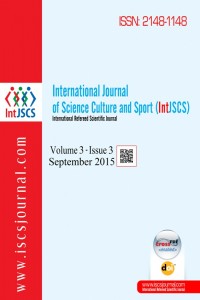Öz
The alpine skiing has undergone major changes and adjustments due to both technological innovations of materials and update of theoretical and methodological concepts on all levels of specific training.
The purpose: the introduction of technological innovation in the field of materials specific to carving ski causes a review of methodology, aiming at bringing the execution technique to superior indices in order to obtain positive results.
The event took place in Poiana Brasov between December 2014 and March 2015, on an 800m long slope and comprised a single experimental group made of four males and four females, cadet category, that carried out two lessons per day. The tests targeted the technique level for slalom skiing and giant slalom skiing, having in view four criteria: leg work, basin movement, torso position and arms work.
As a result of the research and of the statistic-mathematical analysis of the individual values, the giant slalom race registered an average improvement of 3.5 points between the tests, while the slalom race registered 4 points. In conclusion, the use of a specific methodology applied scientifically, which aims to select the most efficient means of action specific to children’s ski, determines technical improvement at an advanced level.
Anahtar Kelimeler
Kaynakça
- Balint G., (2005), Bazele Teoretice şi Metodice ale Predării Schiului, Editura Tehnoexpress, Iaşi
- Bogdan L, Lazar L (2011) – Schi alpin pentru copii, Editura: Risoprint, Cluj
- Federolf P. and colab, (2006), Deformation of snow during a carved ski turn, Elsevier, Cold Regions Science and Technology, Volume 46, Issue 1, p. 69-77, http://www.sciencedirect.com/science/article/pii/S0165232X06000772
- Deutscher Verband fur das Akilehrwesen (DVS) (2002), Ski Lehrplan Perfect, Interski Deutscland, Munchen.
- Federolf P.A. (2005), Finite element simulation of a carving snow ski, doctoral thesis, Germania, http://e-collection.library.ethz.ch/eserv/eth:28070/eth-28070-02.pdf
- Kemler J. (2007)– Richting carven, Blv Buchverlag Gmbh Munchen.
Öz
Kaynakça
- Balint G., (2005), Bazele Teoretice şi Metodice ale Predării Schiului, Editura Tehnoexpress, Iaşi
- Bogdan L, Lazar L (2011) – Schi alpin pentru copii, Editura: Risoprint, Cluj
- Federolf P. and colab, (2006), Deformation of snow during a carved ski turn, Elsevier, Cold Regions Science and Technology, Volume 46, Issue 1, p. 69-77, http://www.sciencedirect.com/science/article/pii/S0165232X06000772
- Deutscher Verband fur das Akilehrwesen (DVS) (2002), Ski Lehrplan Perfect, Interski Deutscland, Munchen.
- Federolf P.A. (2005), Finite element simulation of a carving snow ski, doctoral thesis, Germania, http://e-collection.library.ethz.ch/eserv/eth:28070/eth-28070-02.pdf
- Kemler J. (2007)– Richting carven, Blv Buchverlag Gmbh Munchen.
Ayrıntılar
| Birincil Dil | İngilizce |
|---|---|
| Yazarlar | |
| Yayımlanma Tarihi | 30 Eylül 2015 |
| Yayımlandığı Sayı | Yıl 2015 Cilt 3 - Sayı 3 |

